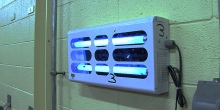
Build a Blockade Against Pests This Summer
By Bill Melville, Quality Assurance Director, Orkin PCO Services
General Integrated Pest Management Orkin Pest ControlWhile summertime still means ‘business as usual’ inside your plant, the warmer weather also means your plant is ‘open for business’ to pests. The warmer weather–and increased pest presence–can bring a new set of challenges to the packaging industry, but revisiting your Integrated Pest Management (IPM) program is a good way to protect your facility from warm weather pest invaders.

Source: Image courtesy of Orkin, LLC.
Pests look for food and water sources, shelter, and optimal temperatures required for survival, and your manufacturing facility can be a welcoming retreat. Once inside, pests can become more than an annoyance–they are a health risk, as well. Pests such as flies and cockroaches transmit bacteria like E. coli that can lead to food poisoning and pneumonia.
If you don’t have an IPM program, you should work with your pest management professional to implement this environmentally friendly approach, eliminating the items pests need to survive, rather than focusing on chemical treatments.
The following are some common summer pests and tips you can easily follow to help keep them out of your packaging facility and protect both your employees and your product.
FLIES
Did you know that it is more sanitary for a cockroach to walk across a surface than for a fly to land on it? Flies are coated in bacteria and have been known to spread disease-causing pathogens such as E. coli, Shigella and Staphylococcus. Implement the following fly control methods into your IPM program:
- Test the air in doorways to confirm a positive airflow that pushes pests out (i.e. air flows out of, rather than into the facility). To test your airflow, stand under a doorway with a piece of tissue paper or hold it near a doorway that is opened slightly–the tissue should blow away from the building. Work with your maintenance professional to make any necessary changes to the building’s HVAC system;
- In areas where doors need to be kept open, such as loading and receiving docks, install air curtains and plastic strip doors. Position fans to blow air down and outward – creating an air current that flies cannot cross. Make sure air curtains are checked regularly to ensure the fans stay positioned correctly and create a complete barrier. Hang plastic strip doors inside entrances to further restrict flying pests from entering;
- Install ultraviolet (UV) light traps with glue boards to trap any flies that enter your facility. Replace all fluorescent and mercury vapor lights outside your facility with sodium vapor bulbs, which are not as attractive to flies.

Source: Image courtesy of Orkin, LLC.
ANTS
When ants appear in sterile production areas they can threaten the safety of products. These small pests can enter through cracks in the floor or the exterior of buildings. While there are about 700 ant species in Canada, it is necessary to know which species you are dealing with so you can treat the problem correctly. Use the following tips to keep ants outside the facility, rather than on the plant floor:
- Ants are tiny pests that can fit through the smallest of cracks. Monitor the exterior of the building for any holes, cracks or crevices and fill them with weather resistant sealant. Eliminate any ant mounds or nests found along the exterior perimeter;
- Ask employees to clean all food out of their lockers at the end of each day. If food is left in the employee break-room, make sure it is in a tightly sealed container. Wipe off all countertops to reduce crumbs left behind for ant sustenance.
COCKROACHES
Roaches carry many different bacteria species that can lead to a number of illnesses. Research has shown that cockroach excrement and cast skins can aggravate allergies and asthma. Apply the tips below to your pest management program to help prevent a cockroach infestation:
- Position dumpsters as far from the facility as possible. Cockroaches can thrive in dirty, moist conditions, such as trash areas. Clean and rotate dumpsters regularly to discourage cockroaches from taking up residence;
- Landscaping can also be attractive to cockroaches in the warmer months. Trim back foliage at least three feet from your building. Cockroaches and other insect pests can use it as a bridge onto the walls. Reduce the number of ground-covering plants such as ivy and mulch, both of which offer harborage for pests;
- Keep the parking and sidewalk areas free of litter. Hose down these areas to remove dust and debris that can draw insect pests toward the building;
- German cockroaches typically ‘hitchhike’ in on shipments and employee items. Check shipments as they come in and throw away any clutter–such as cardboard boxes–that cockroaches use for hiding.

Source: Image courtesy of Orkin, LLC.
Sanitation plays an important role in managing all pests inside your facility. Conduct regular cleanings and be sure to monitor your facility for signs of pests–droppings, cast skins and pests themselves. Enlist your employees in the fight against pests and ask them to keep an eye out for any activity. With the right knowledge, and a team behind you, you can enjoy the summer without having to share your facility with pests.
Bill Melville is the quality assurance director for Orkin PCO Services and has 35 years of experience and is an acknowledged leader in the field of pest management. For more information, e-mail him at bmelville@pcocanada.com or visit www.orkincanada.com.
Advertisement

